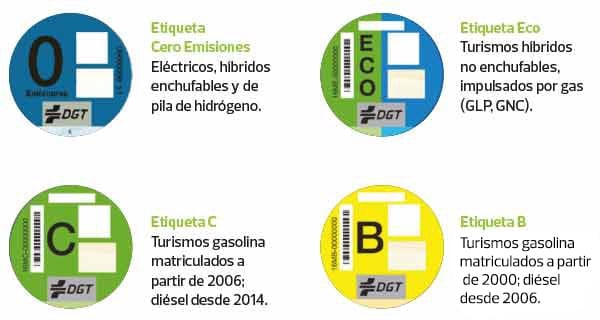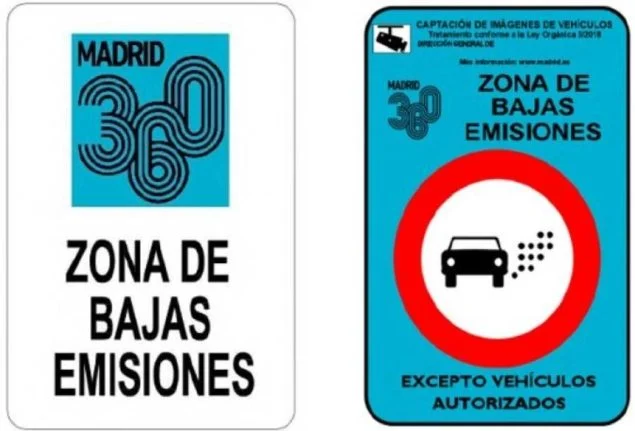The new year has brought a raft of new rules on the roads in Spain.
Not only are there new road signs to learn, and the end of the government’s discount on fuel, but a new crackdown on gas-guzzling cars in densely populated parts of Spain.
As part of the Spanish government’s climate change and energy transition legislation, a series of low-emission zones (Zonas de Bajas Emisiones, ZBE) were introduced across the country from January 1st 2023.
- READ ALSO: The new road signs drivers in Spain need to know in 2023
- READ ALSO: Driving in Spain: What changes in 2023?
- READ ALSO: Spain ends fuel discount for almost all drivers
The aim is to reduce air pollution in Spain’s urban areas and by 2050 have a fleet of cars and light commercial vehicles without direct carbon dioxide emissions, in line with the 2015 Paris Agreement.
The new rules apply to municipalities with more than 50,000 inhabitants, which number 149 across the Spanish territory, and authorities in municipalities with more than 20,000 inhabitants and high air pollution levels will also have to introduce the new measures.
It is worth noting, however, that despite the new rules officially being introduced to start 2023, they are not being actively enforced yet. In fact, many cities have already suggested that it could take some time, such as Zaragoza, which has said it will take months to begin applying it, and Valencia, where the deadline to finalise the rules and fines has been vaguely defined as sometime “in the course of 2023.”
Some places, such as Valladolid, have suggested it could even be 2024 before the details of the system are fully ironed out.
It is recommended that you check the details and timeline for enforcement of ZBEs in your area with the local town hall.
Nonetheless, these low-emission zones basically restrict access, circulation and parking for more environmentally polluting vehicles, although town and city halls will have a certain degree of autonomy as to how they apply the new rules because there are no national rules regulating the specifics as of yet.
The ZBEs will be marked by signposts similar to the ones used in Madrid:
Stickers
As as a result of these ZBEs being rolled out at across Spain, environmental emissions stickers (etiquetas ambientales) are now mandatory for all vehicles that want to drive in areas that have a low-emission zone.
According to the DGT, the equivalent of Spain’s DVLA or DMV, the emissions stickers are a way of “classifying vehicles according to their energy efficiency and taking into account their environmental impact.”
READ ALSO: Driving in Spain: What changes in 2023?
Currently, there are four DGT environmental labels to categorise vehicles according to their impact on the environment. These are:
- Zero (0) emissions (blue sticker): includes most efficient vehicles, electric cars, hydrogen-powered cars and pluggable hybrids.
- ECO (green and blue sticker): includes natural gas and hybrid vehicles.
- C (green sticker): includes petrol cars and vans registered after January 2006, and diesel cars registered after January 2015.
- B (yellow sticker): includes petrol cars and vans registered since January 2001, and diesel cars registered since January 2006.
Cars that are not eligible for a sticker are classified as ‘A’. These are petrol vehicles that were manufactured before 2001 or diesel vehicles manufactured before 2006. They cannot be used in Spain’s existing ZBEs as they’re considered too polluting, and it is unlikely that they will be allowed in any of the newly established ZBEs either. However, classic cars classified as “históricos” will be allowed in ZBEs.

But not everyone has one of these stickers, and with the recent introduction of these new zones, a lot more people could now be needing them.
So, how can you get one?
How and where to get an emissions sticker
The first step is to check your car’s emission classification, which you can do here on the DGT website here by simply entering your registration number.
Once you know your classification, there’s a number of different ways you can get your hands on a sticker. Here’s where you can get or order one:
DGT
On the DGT website here for €6.50, or order one through the the DGT mobile and tablet app.
You can visit this page for more information and download the application.
Correos
Spain’s postal service Correos issues them at a cost of €5. You will have to bring your ID, driving licence and your vehicle’s documents for safety’s sake.
You can also buy it online here, though there is a postal fee of €2.99.
Mechanic workshops
You can also get the tickets at different mechanics workshops across Spain, including Norauto, where you’ll need to take your registration certificate, ID, and pay €5.
Other car mechanic workshops like Euromaster, First Stop, and Sadeco also sell the stickers, where the required documentation and pricing is the same.
CETRAA
Similarly, any CETRAA (Spanish Confederation of Automobile Repair Shops) affiliated workshop can sell the stickers.
GANVAM
GAVNAM, Spain’s National Association of Motor Vehicles, Repairs and Spare Parts, also offers the stickers for fleets of cars (think taxi companies or businesses) and prices range from €6 to €10, depending on the number of stickers purchased.
AMDA dealers
The Asociación Madrileña de Automóviles (AMDA) has made an agreement with DealerBest, offering emissions tickets at €5.5 + IVA (Spain’s VAT), which works out to around €6.65.
The stickers can also be ordered by phone, at 060, or in person at any traffic office. Once ordered, you’ll need to pick up and pay for your sticker at any of the partnered locations listed above.
It is suggested that you pick up an emissions sticker as soon as possible, because in Madrid and Barcelona, where low-emission zones have existed for some time, drivers who don’t have one are often fined with the help of crafty cameras around the city, something sure to be replicated across Spain in its new ZBE’s.





 Please whitelist us to continue reading.
Please whitelist us to continue reading.
Member comments